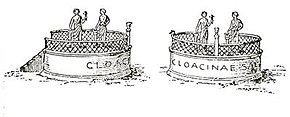Sanctuary of Venus Cloacina


The sanctuary of Venus Cloacina is located southwest of the Basilica Aemilia in the Roman Forum in Rome . All that remains is a small round marble foundation .
The small complex was initially dedicated to the originally Etruscan goddess Cloacina as the patron goddess of Cloaca Maxima , the most important sewer pipe in ancient Rome. Later this goddess was equated with Venus and named Venus Cloacina.
origin
The sanctuary mentioned for the first time in Plautus could go back to the layout of the Cloaca Maxima. Nevertheless, according to Pliny, the sanctuary dates from the time Rome was founded. After the dispute over the robbery of the Sabine women ended, the Romans and Sabines are said to have laid down their weapons in the sanctuary and carried out a purification ceremony at this point. Cloacina was worshiped as the goddess of purity or cleanliness. Its name could therefore also be derived from the Latin verb cloare , to clean. According to another tradition, the cult went back to Titus Tatius .
Location and layout
The sanctuary, which was archaeologically examined from 1899 to 1901 , was located on the Via Sacra near the Tabernae Novae , which were later demolished to make way for the Basilica Aemilia. In the immediate vicinity, the Cloaca Maxima swung into the area of the Velabrum , the former swamp area between the hills. Coins from the time of the Second Triumvirate , such as those of Lucius Mussidius Longus from 42 BC. BC, show a small, round and uncovered sanctuary, only bordered by a balustrade in which two statues were placed. The legend calls it CLOACIN. Contrary to earlier assumptions, the small sanctuary had no access to the Cloaca Maxima below. The round marble base with a diameter of around 2.40 meters and protruding rectangularly on the northwest side has been preserved. According to the coin images, there was a staircase there. The marble plinth rests on a layer of travertine , under which there are eight layers of foundations of different materials, including tuff . This foundation was partially cut when the Basilica Aemilia was being built.
Legend
According to legend, Verginia (or Virginia) is said to have been killed by her father near the sanctuary in order not to have to deliver her up to the tyrannical Decemvirn Appius Claudius Crassus and thus to shame.
literature
- Samuel Ball Platner , Thomas Ashby : A Topographical Dictionary of Ancient Rome . Oxford University Press, London 1929, p. 128 ( online ).
- Lawrence Richardson Jr .: A New Topographical Dictionary of Ancient Rome . Johns Hopkins University Press, Baltimore 1992, p. 92 sv Cloacina, Sacrum .
Web links
Individual evidence
- ^ First mentioned as Venus Cloacina by Pliny , Naturalis historia 15, 119.
- ↑ Plautus , Curculio 471.
- ↑ Pliny, Naturalis historia 15, 119.
- ↑ Lactantius , Divinae institutiones 1, 20, 11.
- ↑ Livy 3:48.
- ^ Herbert Appold Grueber: Coins of the Roman Republic in the British Museum . Volume 1, London 1910, p. 574, nos. 4242-4254.
- ↑ Livy 3, 44-58.
Coordinates: 41 ° 53 ′ 33.1 ″ N , 12 ° 29 ′ 8 ″ E